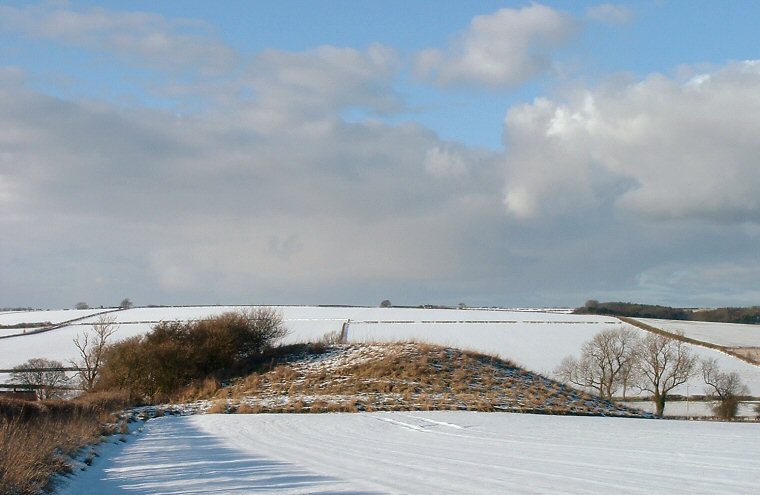
Duggleby Howe barrow looking northwest on a snowy February 29th 2004
Duggleby Howe
is one of the largest round barrows in Britain but it is unusual in that
unlike most round barrows that date from the Bronze Age, this mound was
constructed in the preceding Neolithic. It stands just east of the B1253
road to the south of the village of Duggleby and significantly, about 300 metres from
the source of the Gypsey Race, an intermittent stream that was the focus
of much prehistoric activity in the Great Wold Valley.
Built with an estimated 5000 tons of earth, clay and chalk the barrow was constructed in several phases before finally attaining a diameter of around 38 metres and a height of over 6 metres, its flattened top suggesting it was levelled slightly for the building of a post mill in historic times. The first examination of the site was undertaken by the Rev Christopher Sykes in the late 18th century who seems to have left no record of his findings but it was J. R. Mortimer's excavations in the summer of 1890 that really put Duggleby Howe on the archaeological map.
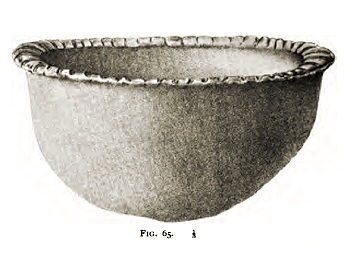 The burial activity at the site started with the digging of a pit about 2.7 metres
deep into the ground surface in which the body of man was placed, possibly
in a wooden coffin along with a crushed middle Neolithic 'Towthorpe' bowl (Mortimer's reconstruction of the bowl shown left), two
flint cores and some flint flakes - this primary burial is now though to date to around 3500BC.
The burial activity at the site started with the digging of a pit about 2.7 metres
deep into the ground surface in which the body of man was placed, possibly
in a wooden coffin along with a crushed middle Neolithic 'Towthorpe' bowl (Mortimer's reconstruction of the bowl shown left), two
flint cores and some flint flakes - this primary burial is now though to date to around 3500BC.
Above him were found the bodies of another adult as well as a child and single skull with the lower jaw missing, the skull having what Mortimer described as a 'suspicious looking circular hole' which may have been the cause of death. A further adult body seems to have been laid on top of the filling of this grave accompanied by an antler mace head, a broken arrow head and end-polished flint axe or adze (image below).
A short distance to the east was a second shallower grave which contained the body of an adult along with some transverse arrowheads, beaver teeth, boar tusks and a bone pin. A further adult body was laid between the two graves accompanied by a remarkably thin polished flint knife only 1.5mm thick (image below).
Sometime between 2800-2700BC the burials were covered by a low mound of earth in which Mortimer discovered the bodies of a further adult, an adolescent and three children as well as several sets of cremation remains. The mound was then extended by covering it with layer of chalk rubble into which more cremated bone was placed, in total fifty-three cremation deposits were found although as the entire site was not excavated Mortimer estimated the total number may have been double this. This mound was then capped with a layer of clay effectively sealing the burials and cremations and a further thick layer of chalk rubble piled over it to create the final massive barrow form. This 'monumentalizing' of the mound may have been the final act in the building of the barrow but finds of pottery sherds, shears and bones in the upper chalk layer suggest it was partly reused for burial during the Anglo-Saxon period.
Aerial photography in recent years has shown that Duggleby Howe stands in the centre of a large circular enclosure consisting of a wide inner ditch, a narrower outer ditch and a series of causeways. The diameter of this enclosure is around 370 metres - it is now all but ploughed out and silted up but parts of it are still visible on the satellite image below as are the ring ditches of a handful of round barrows just within and outside of the enclosure towards the east. In the past there has been some uncertainty as to whether the earthwork represents a causewayed enclosure, a formative henge, a local hybrid development or even what its chronological relationship to the barrow is. While it is possible that it was dug at the same time as the first phase of burials as a way of demarcating a sacred area recent research suggests that it may be a much later addition to the site and was used as the source quarry for the chalk used in the final enlargement phase of the barrow sometime between 2400-2300BC.
See also the similar barrow of Willie Howe or the Rudston maps and introduction page.
Built with an estimated 5000 tons of earth, clay and chalk the barrow was constructed in several phases before finally attaining a diameter of around 38 metres and a height of over 6 metres, its flattened top suggesting it was levelled slightly for the building of a post mill in historic times. The first examination of the site was undertaken by the Rev Christopher Sykes in the late 18th century who seems to have left no record of his findings but it was J. R. Mortimer's excavations in the summer of 1890 that really put Duggleby Howe on the archaeological map.
 The burial activity at the site started with the digging of a pit about 2.7 metres
deep into the ground surface in which the body of man was placed, possibly
in a wooden coffin along with a crushed middle Neolithic 'Towthorpe' bowl (Mortimer's reconstruction of the bowl shown left), two
flint cores and some flint flakes - this primary burial is now though to date to around 3500BC.
The burial activity at the site started with the digging of a pit about 2.7 metres
deep into the ground surface in which the body of man was placed, possibly
in a wooden coffin along with a crushed middle Neolithic 'Towthorpe' bowl (Mortimer's reconstruction of the bowl shown left), two
flint cores and some flint flakes - this primary burial is now though to date to around 3500BC. Above him were found the bodies of another adult as well as a child and single skull with the lower jaw missing, the skull having what Mortimer described as a 'suspicious looking circular hole' which may have been the cause of death. A further adult body seems to have been laid on top of the filling of this grave accompanied by an antler mace head, a broken arrow head and end-polished flint axe or adze (image below).
A short distance to the east was a second shallower grave which contained the body of an adult along with some transverse arrowheads, beaver teeth, boar tusks and a bone pin. A further adult body was laid between the two graves accompanied by a remarkably thin polished flint knife only 1.5mm thick (image below).
Sometime between 2800-2700BC the burials were covered by a low mound of earth in which Mortimer discovered the bodies of a further adult, an adolescent and three children as well as several sets of cremation remains. The mound was then extended by covering it with layer of chalk rubble into which more cremated bone was placed, in total fifty-three cremation deposits were found although as the entire site was not excavated Mortimer estimated the total number may have been double this. This mound was then capped with a layer of clay effectively sealing the burials and cremations and a further thick layer of chalk rubble piled over it to create the final massive barrow form. This 'monumentalizing' of the mound may have been the final act in the building of the barrow but finds of pottery sherds, shears and bones in the upper chalk layer suggest it was partly reused for burial during the Anglo-Saxon period.
Aerial photography in recent years has shown that Duggleby Howe stands in the centre of a large circular enclosure consisting of a wide inner ditch, a narrower outer ditch and a series of causeways. The diameter of this enclosure is around 370 metres - it is now all but ploughed out and silted up but parts of it are still visible on the satellite image below as are the ring ditches of a handful of round barrows just within and outside of the enclosure towards the east. In the past there has been some uncertainty as to whether the earthwork represents a causewayed enclosure, a formative henge, a local hybrid development or even what its chronological relationship to the barrow is. While it is possible that it was dug at the same time as the first phase of burials as a way of demarcating a sacred area recent research suggests that it may be a much later addition to the site and was used as the source quarry for the chalk used in the final enlargement phase of the barrow sometime between 2400-2300BC.
See also the similar barrow of Willie Howe or the Rudston maps and introduction page.
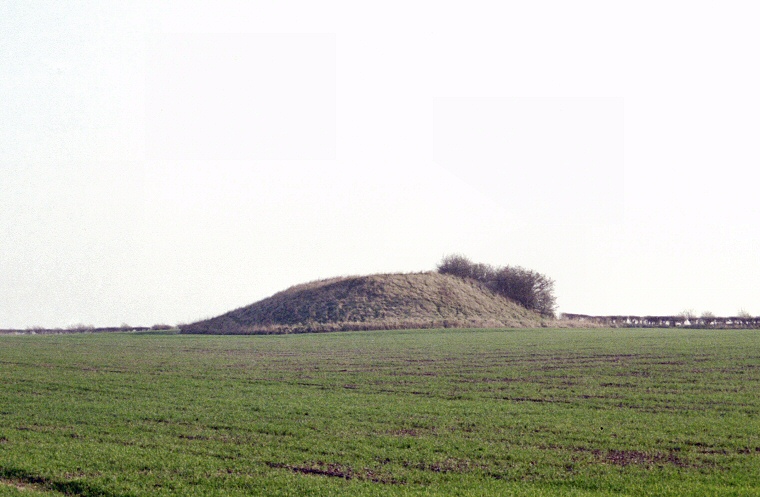
View of the barrow looking southeast from the village of Duggleby.
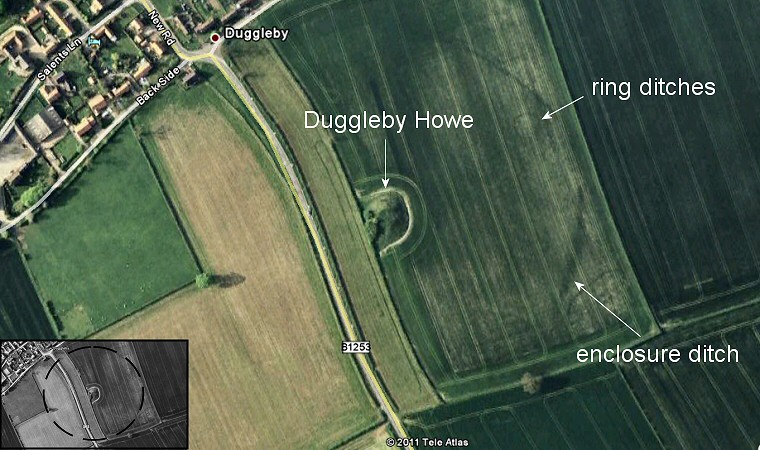
Google Earth image of Duggleby Howe at the centre of a large ditched enclosure
(crop marks of ditch shown as a dashed line on inset image).
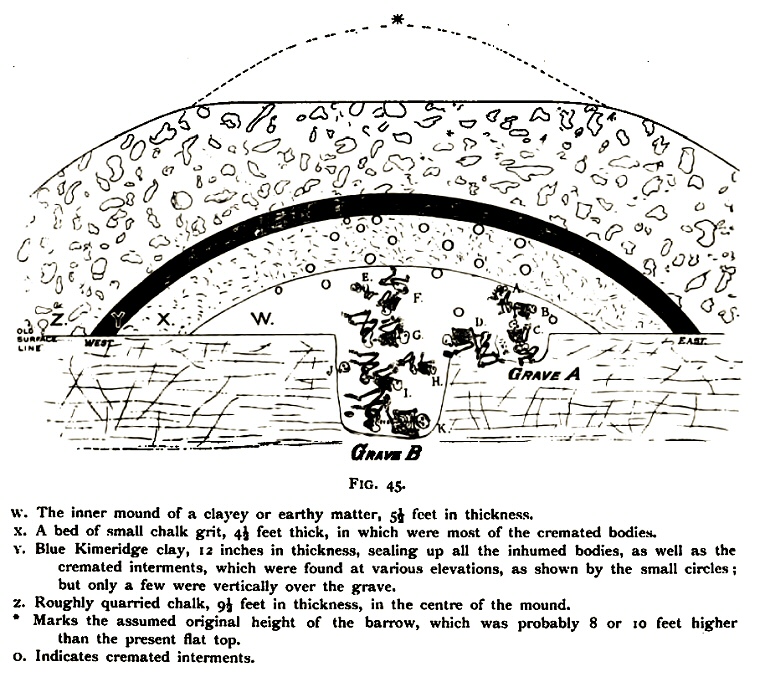
Mortimer's section drawing of Duggleby Howe from 'Forty years researches in British and Saxon burial mounds of East Yorkshire' published in 1905.
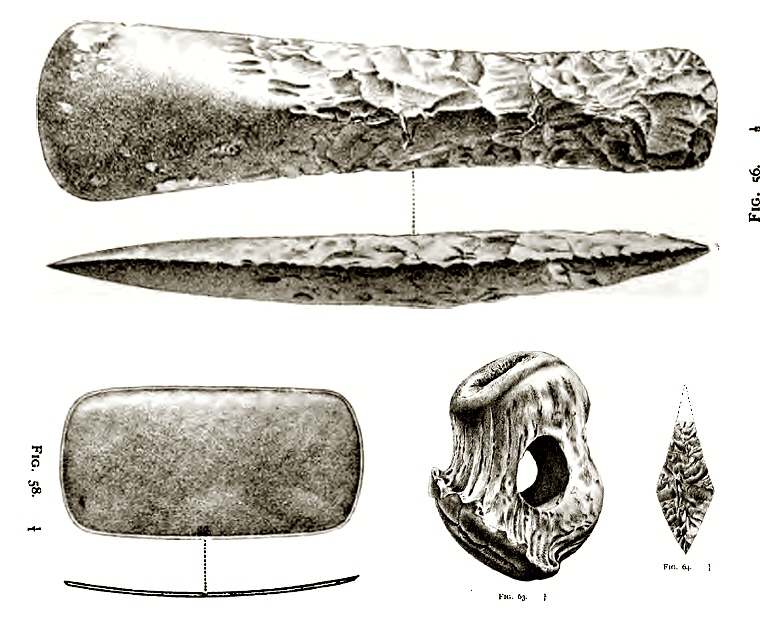
Some of the finds from Duggleby Howe, taken from Mortimer 1905. Top: Axe or adze. Bottom: Flint knife, antler mace head and broken arrow. The quality of the workmanship of the axe and particularly the extraordinarily thin knife measuring only 1.5 mm thick suggests that these were prestige pieces owned by an elite group and designed for display as much as use as practical tools.
Site Visits / Photographs:
August 2001, February 2003, February 2004.
References:
Cope, J. 1998. The Modern Antiquarian. A Pre-Millennial Odyssey through Megalithic Britain. London: Thorsons.
Darvill, T. 2010. Prehistoric Britain. 2nd Edition. Abingdon: Routledge.
Dennett, K. 2011. Recent Work at Duggleby Howe. Summary of the lecture given to ERAS by Dr. Alex Gibson. ERAS Newsletter 75.
Dyer, J. (Editor). 1993. Discovering Prehistoric England. Princes Risborough: Shire Publications Ltd.
Elgee, F. & H.W. 1933. The Archaeology of Yorkshire. London: Methuen & Co.
Gibson, A. 1986. Neolithic and Early Bronze Age Pottery. Princes Risborough: Shire Publications Ltd.
Gibson, A. 2011. Report on the excavation at Duggleby Howe causewayed enclosure.... Archaeological Journal. 168, 1-63.
Grinsell, L. V. 1936. The Ancient Burial Mounds of England. London: Methuen.
Hawkes, J. 1986. The Shell Guide to British Archaeology. London: Michael Joseph Ltd.
Manby, T. 1979. Typology, materials, and distribution of flint and stone axes in Yorkshire. In Stone Axe Studies. CBA Report 23, 65-81.
Manby, T. 1988. The Neolithic Period in Eastern Yorkshire. In Manby, T., ed. Archaeology in Eastern Yorkshire. Collis, 35-88.
Mortimer, J.R. 1905. Forty Years Researches in British and Saxon Burial Mounds of East Yorkshire. London: Brown.
Oswald, A., Dyer, C. and Barber, M. 2001. The Creation of Monuments. Neolithic Causwayed Enclosures... English Heritage.
Prehistoric Society. -. Duggleby Howe, North Yorkshire (SE880669).
Pollard, J. 1997. Neolithic Britain. Princes Risborough: Shire Publications Ltd.
Sheppard, T. 1929. Catalogue of the Mortimer Collection of Prehistoric Remains from East Yorkshire Barrows. Hull: Brown.
Stoertz, C. 1997. Ancient Landscapes of the Yorkshire Wolds. Aerial photographic transcription and analysis. RCHME.
Woodward, A. 2000. British Barrows. A Matter of Life and Death. Stroud: Tempus Publishing Ltd.
Historic England Research Records Hob Uid: 61899.
NY SMR Number: MNY4140. NMR Number: SE86NE2.